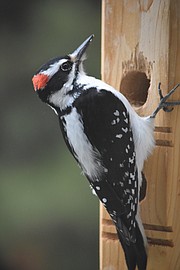The hairy woodpecker: A familiar visitor to bird feeders!
“Advice from a woodpecker: find your own rhythm, carve out a place for yourself, make your voice heard, it’s OK to be a little flashy, use your head!”
— Author unknown
During this winter I had noticed on several occasions a small- to medium-size bird foraging mainly on the trunks and limbs of trees and sometimes on shrubs. It was an energetic bird in his search, often probing, scaling off bark, and excavating into dead wood in pursuit of insects.
The bird had a fairly square head, a long, straight, chisel-like bill, and stiff, long tail feathers to lean against on tree trunks. His bill was nearly the same length as his head. The bird was entertaining as he would hitch up tree trunks and along main branches in search of his food. He would sometimes feed at the base of trees, along fallen logs, and even on the ground and particularly at my suet bird feeders. He had a slowly undulating flight pattern like most woodpeckers.
After consulting my Birds of Idaho field guide I determined the bird was a common woodpecker of wooded backyards that announces its arrival with a sharp chirp before landing on feeders or near trees. This bird is called a Hairy Woodpecker (Picoides villosus) and is responsible for eating many destructive forest insects. He has a barbed tongue, which helps it extract insects from trees. The woodpecker has tiny bristle-like feathers at the base of his bill protecting the nostrils from wood dust. The Hairy Woodpecker is known to drum on hollow logs, branches or stovepipes in the springtime to announce its territory.
Adults are mainly black on the upper parts and wings, with a white or pale back and white spotting on the wings; the throat and belly vary from white to sooty brown. There is a white bar above and below the eye. They have a black tail with white outer feathers. Adult males have a red patch or two side-by-side patches on the back of the head; juvenile males have red or rarely orange-red on the crown.
The hairy woodpecker measures from 7–10 inches in length, 13–17 inches in wingspan and one to three ounces in weight. It is virtually identical in plumage to the smaller downy woodpecker. The downy has a shorter bill relative to the size of its head which is, other than size and voice, the best way to distinguish them in the field.
Hairy woodpeckers generally lay three to six white eggs without markings. Incubation is by both sexes (with male incubating at night, female most of the day) and generally lasts about 14 days. Both parents feed the nestlings during their maturation. The male has been known to forage farther from the nest, making fewer feeding trips with more food each time than the female. The young woodpeckers leave the nest 28-30 days after hatching and are fed by parents for some time afterward. The Hairy Woodpecker has one brood per year.
The hairy woodpecker eats mostly insects. They feed especially on larvae of wood-boring beetles, also other beetles, ants, caterpillars, some berries, seeds and nuts. They will feed on sap at damaged trees or at the workings of a sapsucker, and often will come to bird feeders for suet.
The male and female may maintain separate territories in early winter, pairing up in mid-winter, often with their mate from the previous year. The female’s winter territory generally becomes the focus of the nesting territory. Courtship includes both birds drumming in duet; ritualized tapping at symbolic nest sites by female. The nest site is a cavity (excavated by both sexes), mainly in dead conifers. The cavity is usually up to 60 feet above ground.
In my research I was interested to find that these birds are mostly permanent residents; consequently I expect to be woken up to the drumming of the hairy woodpecker this winter and spring, unless he is quietly enjoying our suet feeder.
I have heard that some woodpeckers attack house siding. They may be able to hear wood-boring insects inside a tree trunk but mistake the hum of electricity in house-hold wiring for insect activity.
Discover Boundary County’s wildlife. Enjoy the outdoors!



